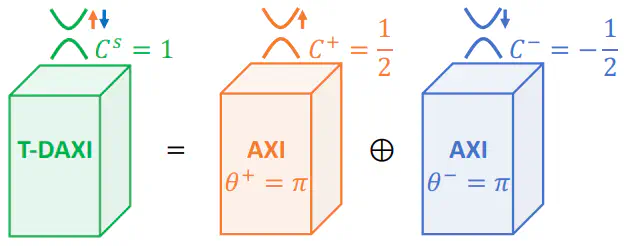Partial Axion Angles and Spin-Resolved Topology in Nature Communications
 A helical HOTI as a time-reversal-doubled axion insulator (T-DAXI)
A helical HOTI as a time-reversal-doubled axion insulator (T-DAXI)Our discovery of novel topological surface anomalies in real materials through the framework of spin-resolved topology was published this week in Nature Communications.
Over the past 7 years, groups including our own have predicted and analyzed real-material realizations of topological crystalline insulator (TCI) states. However, nonmagnetic TCI phases have so far only reliably exhibited observable signatures in theoretical models with unrealistically high degrees of symmetry, far exceeding the symmetry of even the best real-material samples. By introducing extensive numerical and theoretical tools to analyze nonmagnetic TCIs via their electronic spin degree of freedom, we discovered the existence of time-reversal-doubled “partial” axion angles and insulators (T-DAXIs), which together provide a novel and intuitive way of understanding TCI states — and crucially their surface anomalies and responses — without enforcing unrealistic system symmetries. Most excitingly, we discovered that the readily accessible material α-BiBr realizes T-DAXI physics while hosting a particularly simple bulk spin-orbital texture, making it an ideal platform for future experimental investigations of spin-dependent topological response effects.
This work also coincides with the public release of our open-source Python package for performing spin-resolved and nested Wilson loop topological calculations, which was developed over the past 6 years for several works from our group, as well as the present study.
Further details are available through our press release, through the English and French news coverage by the IPhT, and through articles highlighting our work in Laser Focus World and Physics World.
Jan. 17, 2024